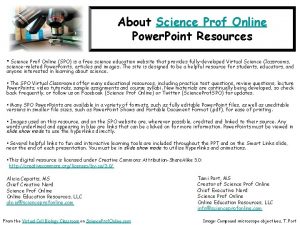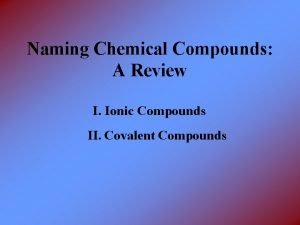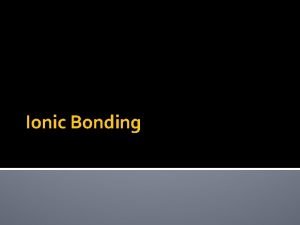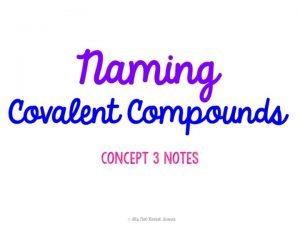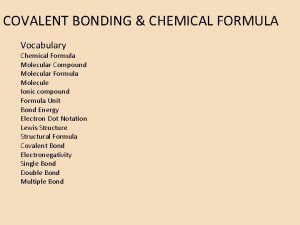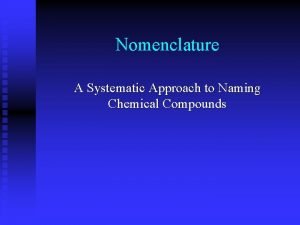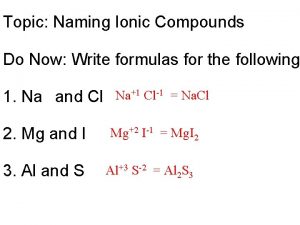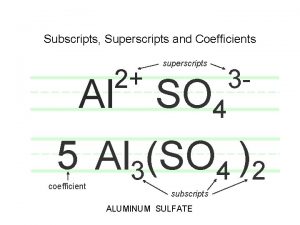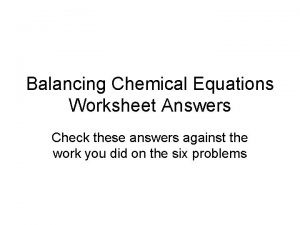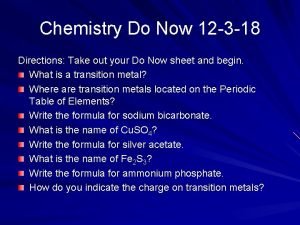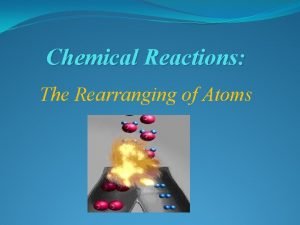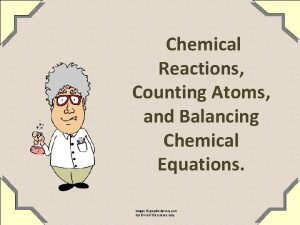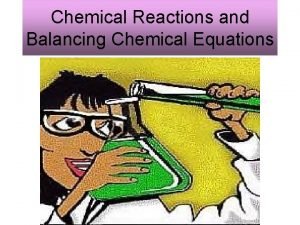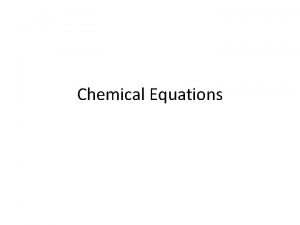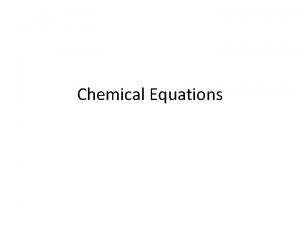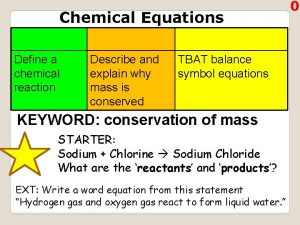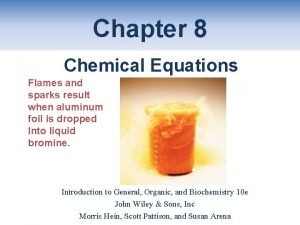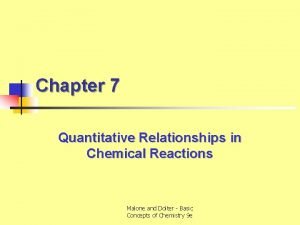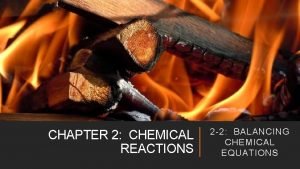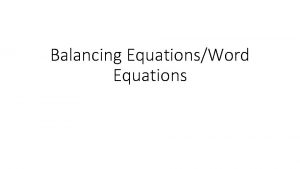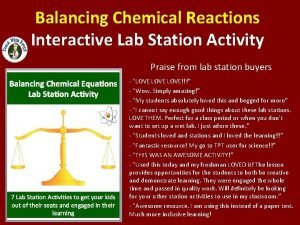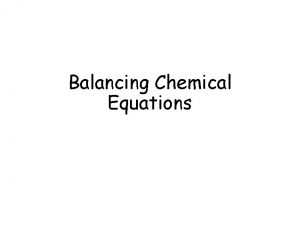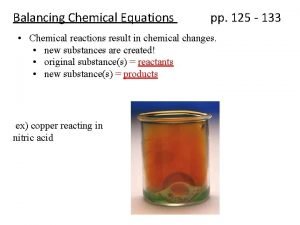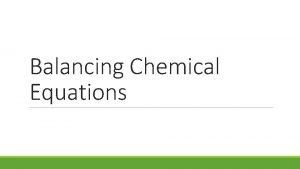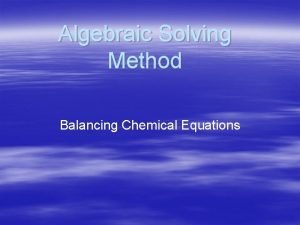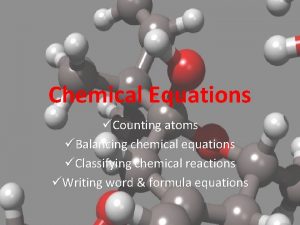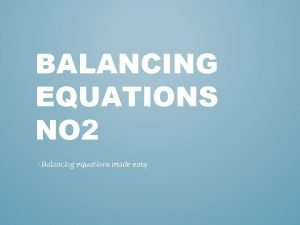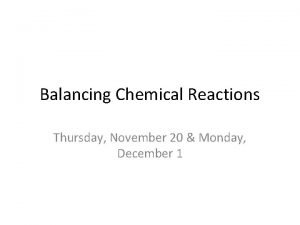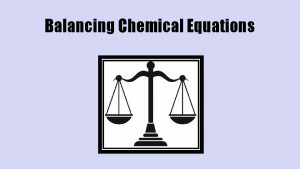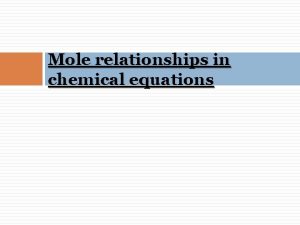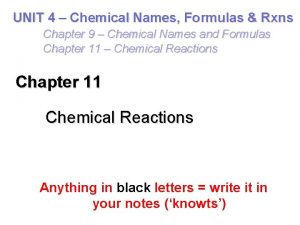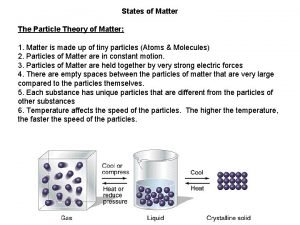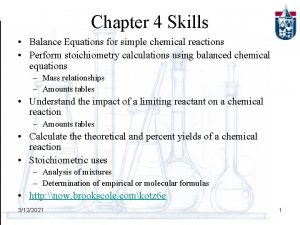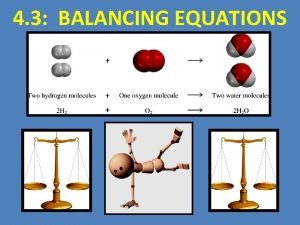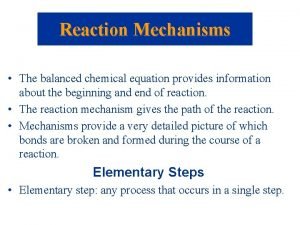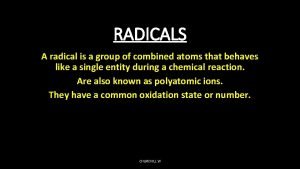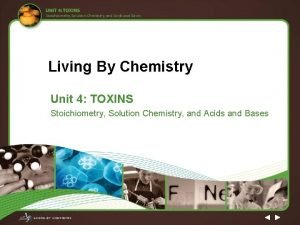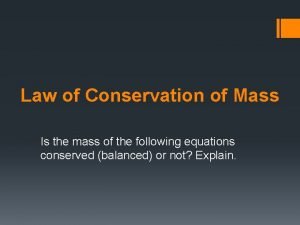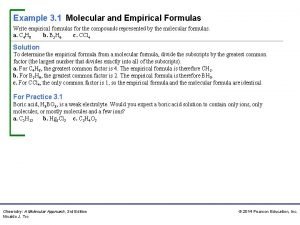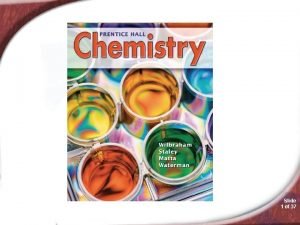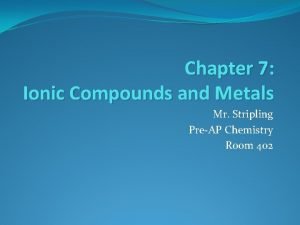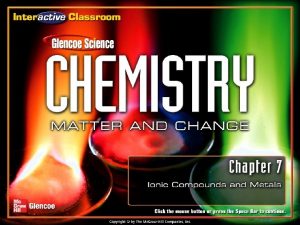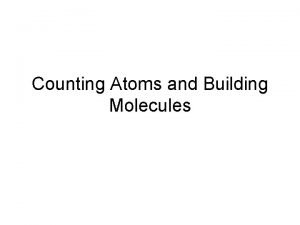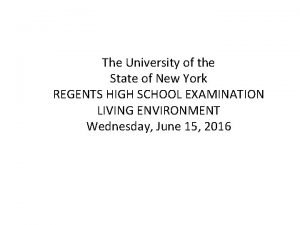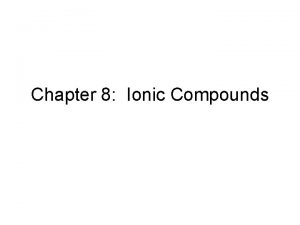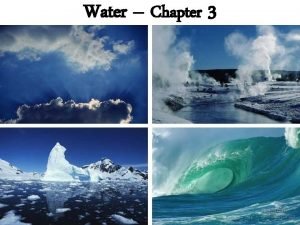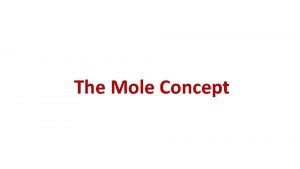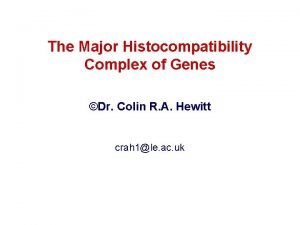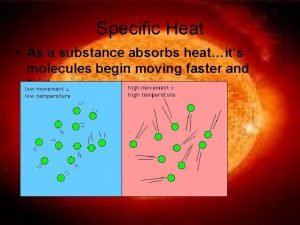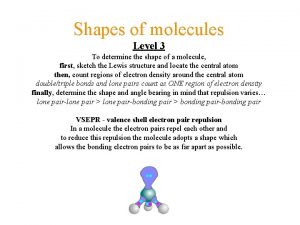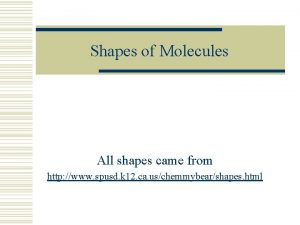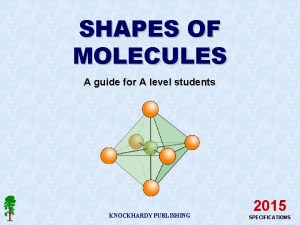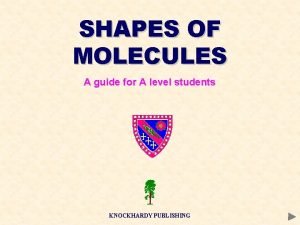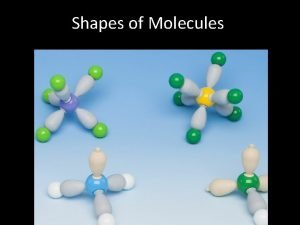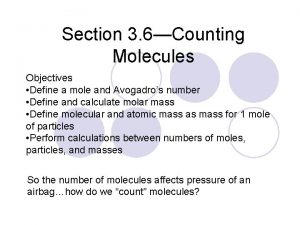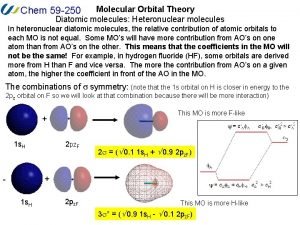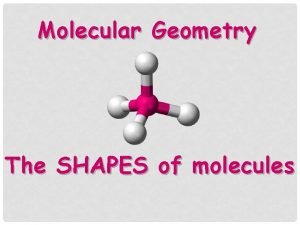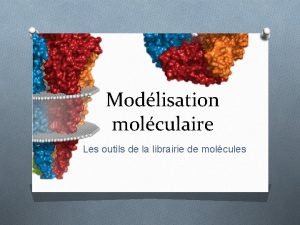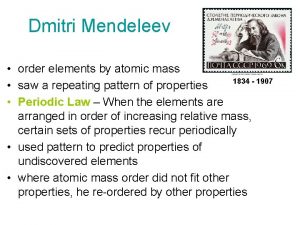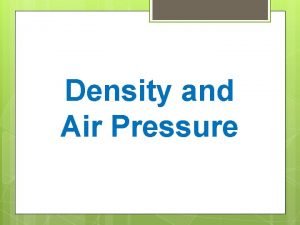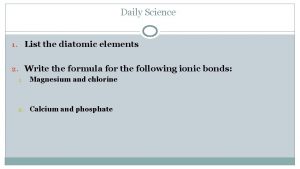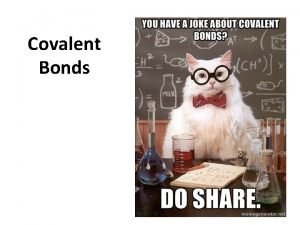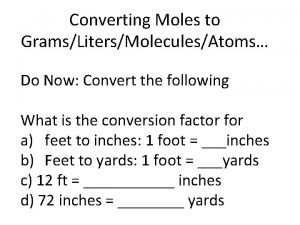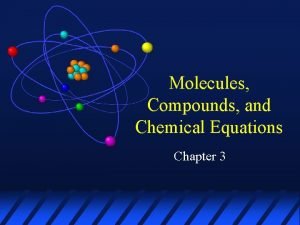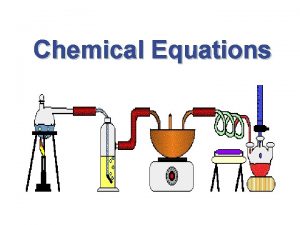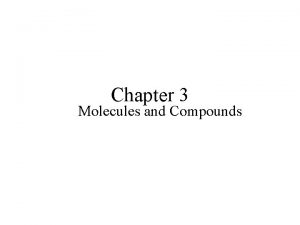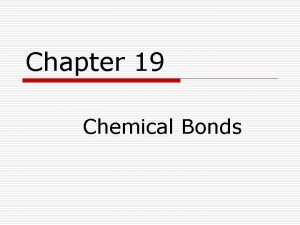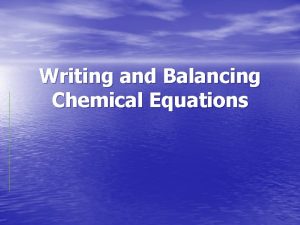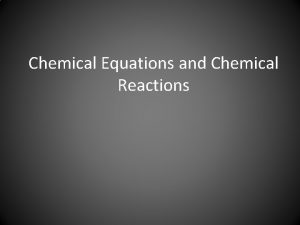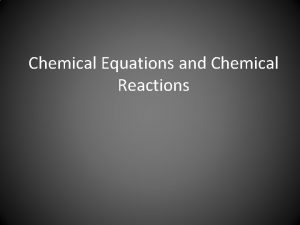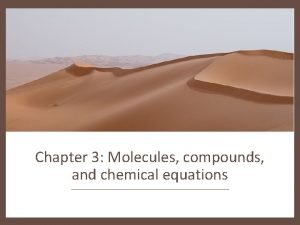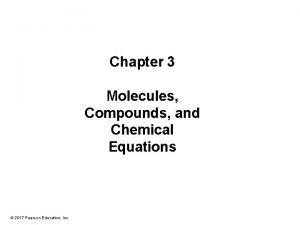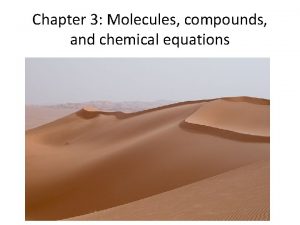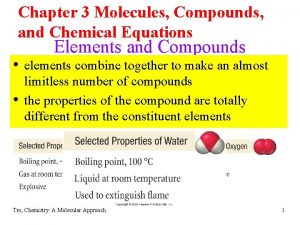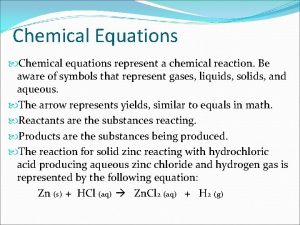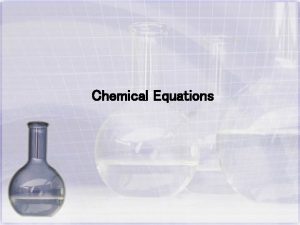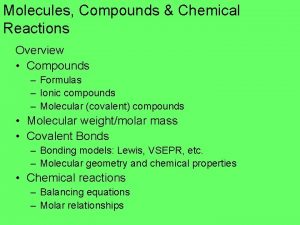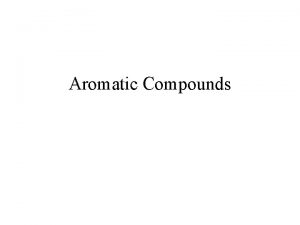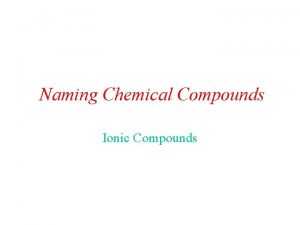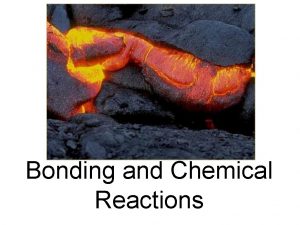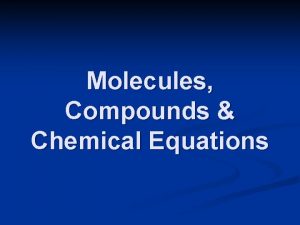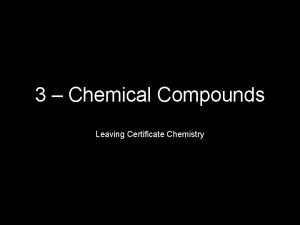Chapter 3 Molecules Compounds and Chemical Equations Chapter


























































































































- Slides: 122

Chapter 3 Molecules, Compounds and Chemical Equations

Chapter 3 Molecules, Compounds and Chemical Equations 3. 1 3. 2 3. 3 3. 4 3. 5 3. 6 3. 7 3. 8 3. 9 3. 10 3. 11 3. 12 Hydrogen, Oxygen and Water Chemical Bonds Representing Compounds: Chemical Formulas and Molecular Models An Atomic Level View of Elements and Compounds Ionic Compounds: Formulas and Names Molecular Compounds: Formulas and Names Summary of Inorganic Nomenclature Formula Mass and the Mole Concept for Compounds Composition of Compounds Determining a Chemical Formula from Experimental Data Writing and Balancing Chemical Equations Organic Compounds 2

Section 3. 1 Hydrogen, Oxygen and Water Mixtures vs Compounds • When two or more elements combine to form a compound an entirely new substance results. – Balloon contains a mixture of hydrogen (H 2) and oxygen gas (O 2) – Glass contains a compound composed of hydrogen and oxygen (H 2 O) 3

Section 3. 1 Hydrogen, Oxygen and Water Properties of Hydrogen, Oxygen and Water 4

Section 3. 1 Hydrogen, Oxygen and Water Sodium Chloride Na. Cl When two or more elements combine to form a compound an entirely new substance results. Sodium (Na) = Soft reactive metal Chlorine (Cl) = toxic gas Sodium Chloride (Na. Cl) = Tasty condiment/preservative 5

Section 3. 2 Chemical Bonds Ionic vs covalent bonds • When elements combine with each other bonds form. – Ionic bonds – Covalent bonds 6

Section 3. 2 Chemical Bonds Ionic Bonds • Ionic bonds form when one atom loses electrons and another atom gains electrons. – Metal atoms tend to lose electrons and become positive cations – Nonmetal atoms tend to gain electrons and become negative anions 7

Section 3. 2 Chemical Bonds Ionic Bonds • The oppositely charged ions attract one another by electrostatic forces and form an ionic bond • The result is an ionic compound, which (in the solid phase) is composed of a lattice – a regular three dimensional array of cations and anions 8

Section 3. 2 Chemical Bonds Ionic Bonds 9

Section 3. 2 Chemical Bonds Covalent Bonds • Covalent bonds form when two atoms share electrons – Form between non-metals – neither are willing to give up electrons so in order to form a bond – they share. 10

Section 3. 2 Chemical Bonds Covalent Bonds • Water (H 2 O), ammonia (NH 3), and Methane (CH 4) all have covalent bonds. A covalent bond is a shared pair of electrons (represented here by a line). Notice covalent compounds are individual units (molecules) 11

Section 3. 2 Chemical Bonds Why do bonds form? • Bonds form to lower the potential energy of the atoms – In the process each atom ends up with an octet of electrons (8 electrons in outer shell) – This is the result – Not the driving force • The driving force in nature is ALWAYS to increase stability (lower potential energy). 12

Section 3. 3 Representing Compounds: Chemical Formulas and Molecular Models Types of Chemical Formulas • Empirical formula – Simplest – tells what types of atoms are present in a compound – Empirical formula for hydrogen peroxide is HO • Molecular Formula – Give the actual number of atoms in a compound – Molecular formula for hydrogen peroxide is H 2 O 2 • Structural Formula – Can be simple – Can indicate geometry of the compound 13

Section 3. 3 Representing Compounds: Chemical Formulas and Molecular Models Types of Chemical Formulas • Structural Formula – Can be simple (L) – Can indicate geometry of the compound (R) 14

Section 3. 3 Representing Compounds: Chemical Formulas and Molecular Models • Ball and Stick Models – Atoms are balls and bonds are sticks • Space filling Models – Atoms fill the spaces between each other – Probably the most “accurate” way to imagine a molecule if it was blown up to a size we could see 15

Section 3. 3 Representing Compounds: Chemical Formulas and Molecular Models Representing Molecules Table 3. 1 16

Section 3. 4 An Atomic-Level View of Elements and Compounds Elements vs Compounds • Pure substances can be elements (H 2, Ca) or compounds (H 2 O, Ca. Cl 2) (Ch 1) 17

Section 3. 4 An Atomic-Level View of Elements and Compounds Elements vs Compounds • Elements and Compounds can be further categorized based on the types of units that compose them 18

Section 3. 4 An Atomic-Level View of Elements and Compounds Elements vs Compounds • Elements can be atomic (exist as individual atoms) or molecular (oxygen is a diatomic molecule). There are even polyatomic elements (next slide). 19

Section 3. 4 An Atomic-Level View of Elements and Compounds Molecular Elements • H 2, N 2, O 2, F 2, Cl 2, Br 2 and I 2 • P 4 • S 8, Se 8 • You should learn the 7 diatomic elements 20

Section 3. 4 An Atomic-Level View of Elements and Compounds Elements vs Compounds • • • Compounds can be molecular (H 2 O) or ionic (Na. Cl) The smallest unit of a molecular compound is the molecule The smallest unit of an ionic compound is a formula unit 21

Section 3. 4 An Atomic-Level View of Elements and Compounds Molecules vs Formula Units • How is a molecule of water (H 2 O) different than a formula unit of sodium chloride (Na. Cl). • A water molecule is a discrete unit that consists of three atoms tightly bound together. • A sodium chloride formula unit is the smallest unit of a sample of Na. Cl. The forces (electrostatic) holding these ions together are very weak so an individual Na. Cl is not stable. Sodium chloride only holds together as a stable structure in the lattice form with many millions of ions all bound together. 22

Section 3. 5 and 3. 6 Ionic and Molecular Compounds Types of Compounds • Binary Ionic Compounds – Metal—nonmetal Na. Cl, Ca. Br 2 • Ionic Compounds with Polyatomic Ions − Ions with more than one atom • Hydrated Ionic Compounds • Na. NO 3, NH 3 Cl Mg. SO 4 7 H 2 O Binary Covalent Compounds – Nonmetal—nonmetal CO 2, H 2 O, NH 3 23

Section 3. 5 Ionic Compounds: Formulas and Names Writing Formulas for Ionic Compounds • Binary Ionic Compounds form between a metal and a nonmetal – Metal forms a cation – Non metal forms an anion • The compounds are charge neutral • Many elements form only one type of ion • For these two reasons it is fairly simple to reason out the formula of most compounds just by knowing the identity of the component elements. 24

Section 3. 5 Ionic Compounds: Formulas and Names Writing Formulas for Ionic Compounds • If you have sodium (Na) and chlorine (Cl) – – Only one compound can form Na loses an electron to form a Na+ cation Cl gains an electron to form a Cl– anion They combine 1: 1 to form Na. Cl • If you have calcium (Ca) and chlorine (Cl) – – Only one compound can form Ca loses 2 electrons to form a Ca 2+ cation Cl gains an electron to form a Cl– anion They combine 1: 2 to form Ca. Cl 2 25

Section 3. 5 Ionic Compounds: Formulas and Names Learning Check • Write formulas for ionic compounds formed from the following element 1. Sodium and Oxygen 2. Calcium and bromine 3. Magnesium and aluminum 26

Section 3. 5 Ionic Compounds: Formulas and Names Naming Ionic Compounds • Ionic compounds have common names and systematic names • Na. Cl is sodium chloride or table salt (common name) • Na. HCO 3 is sodium bicarbonate or baking soda (common name) • We will learn the systematic naming system 27

Section 3. 5 Ionic Compounds: Formulas and Names Naming Ionic Compounds • Binary Ionic compounds from metals and non metals – Metals are of two types • Metals that only make one type of cation – Groups I -3 • Metals that can from more than one type of cation – Transition Group Metals and Main Groups 4 and above (basically everything else) 28

Section 3. 5 Ionic Compounds: Formulas and Names Naming Binary Ionic Compounds Containing a Metal that Forms Only One Type of Cation 1. The cation is always named first and the anion second. 2. A monatomic cation takes its name from the name of the parent element. 3. A monatomic anion is named by taking the root of the element name and adding –ide. 29

Section 3. 5 Ionic Compounds: Formulas and Names Naming Binary Ionic Compounds Containing a Metal that Forms Only One Type of Cation KCl Potassium chloride Mg. Br 2 Magnesium bromide Ca. O Calcium oxide 30

Section 3. 5 Ionic Compounds: Formulas and Names Concept Check Write the names of the following compounds. A. Mg. O B. Al 2 S 3 C. Mg. F 2 31

Section 3. 5 Ionic Compounds: Formulas and Names Naming Binary Ionic Compounds Containing a Metal that Form More than One Type of Cation • Metals in these compounds form more than one type of positive ion Charge on the metal ion must be specified. Roman numeral indicates the charge of the metal cation. Transition metals and large metals (period IV and higher usually require a Roman numeral • • Exceptions: Ag+, Cd 2+, Zn 2+ (form only a single ion) 32

Section 3. 5 Ionic Compounds: Formulas and Names Naming Binary Ionic Compounds Containing a Metal that Form More than One Type of Cation 1. The cation is always named first and the anion second. 2. A monatomic cation takes its name from the name of the parent element. 3. Charge of cation in roman numerals (in parenthesis) 3. A monatomic anion is named by taking the root of the element name and adding –ide. 33

Section 3. 5 Ionic Compounds: Formulas and Names Naming Binary Ionic Compounds Containing a Metal that Form More than One Type of Cation Cu. Br Copper (I) bromide Fe. S Iron (II) sulfide Pb. O 2 Lead (IV) oxide Figure out the charge on the cation based on the charge of the anion. 34

Section 3. 5 Ionic Compounds: Formulas and Names Learning Check Name the following ionic compounds containing metals that form two kinds of positive ions: A. Fe 2 O 3 B. Sn. Cl 2 C. Pb. I 4 35

Section 3. 5 Ionic Compounds: Formulas and Names Naming Ionic Compounds Containing Polyatomic Ions • Naming these compounds is the same only now we use the name of the polyatomic ion wherever it occurs 36

Section 3. 5 Ionic Compounds: Formulas and Names Naming Ionic Compounds Containing Polyatomic Ions • • Must be memorized (polyatomic ion handout). Examples of compounds containing polyatomic ions: Na. OH Sodium hydroxide Pb(NO 3)2 lead (II) nitrate (NH 4)2 SO 4 Ammonium sulfate 37

Section 3. 5 Ionic Compounds: Formulas and Names Learning Check Write the names of the following compounds. A. Na. C 2 H 3 O 2 B. Ca 3(PO 4)2 C. Cu. NO 2 D. K 2 Cr 2 O 7 E. Mg. Cl. O 2 F. NH 4 CN Chemistry: An Introduction to General, Organic, and Biological Chemistry, Eleventh Edition Copyright © 2012 by Pearson Education, Inc. 38

Section 3. 5 Ionic Compounds: Formulas and Names Hydrated Ionic Compounds • Some ionic compounds are hydrates • This means they have a specific number of water molecules associated with each formula unit in the lattice structure • An example is magnesium sulfate heptahydrate • Mg. SO 4 7 H 2 O 39

Section 3. 5 Ionic Compounds: Formulas and Names Hydrated Ionic Compounds • Cobalt chloride hexahydrate before and after heating to drive off the water 40

Section 3. 5 Ionic Compounds: Formulas and Names Common hydrate prefixes • • • Hemi = ½ Mono = 1 Di = 2 Tri = 3 Tetra = 4 Penta = 5 Hexa = 6 Hepta = 7 Octa = 8 These prefixes are also used in naming molecular compounds For example: carbon dioxide 41

Section 3. 6 Molecular Compounds: Formulas and Names Molecular compounds vs Ionic Compounds • Ionic compounds form between metal and non metal – The ions in ionic compounds can only combine one way because compounds are charge neutral – Na+ and Cl– can only combine one way • Molecular compounds form between two nonmetals – The atoms in molecular compounds don’t form ions – they share electrons. For this reason the same combination of elements can form a number of different molecular compounds. 42

Section 3. 6 Molecular Compounds: Formulas and Names Naming Molecular Compounds 1. The first element in the formula is named first, using the full element name. 2. The second element is named as if it were an anion. 3. Prefixes are used to denote the numbers of atoms present. 4. The prefix mono- is never used for naming the first element. 43

Section 3. 6 Molecular Compounds: Formulas and Names Naming Molecular Compounds Prefixes Used to Indicate Number in Chemical Names 44

Section 3. 6 Molecular Compounds: Formulas and Names Naming Molecular Compounds CO 2 Carbon dioxide SF 6 Sulfur hexafluoride N 2 O 4 Dinitrogen tetroxide 45

Section 3. 6 Molecular Compounds: Formulas and Names Learning Check Write the name of each covalent compound. A. Se. O B. NO 2 C. PF 3 D. CBr 4 E. P 2 O 5 46

Section 3. 6 Molecular Compounds: Formulas and Names Conceptual Connection • The compound NCl 3 is nitrogen trichloride , but Al. Cl 3 is just aluminum chloride. Why? 47

Section 3. 6 Molecular Compounds: Formulas and Names Acids • Acids can be defined as molecular compounds than release hydrogen ions (H+) when dissolved in water. • Acids are composed of hydrogen, usually written first in the formula, followed by one or more non metals. • Two categories of acids for naming – Binary acids – Oxy Acids 48

Section 3. 6 Molecular Compounds: Formulas and Names Naming Binary Acids • • Hydrogen plus a non metal, the acid is named with the prefix hydro– followed by the root of the anion and the suffix –ic. Examples: HCl Hydro chlor ic acid HBr Hydro brom ic acid H 2 S Hydro sulfur ic acid Notice sulfur is kind of a weirdo sulfur instead of sulf 49

Section 3. 6 Molecular Compounds: Formulas and Names Naming Oxy. Acids • Hydrogen plus an oxyanion (anion containing a nonmetal and oxygen) § § The suffix –ic is added to the root name if anion name ends in –ate. : HNO 3 Nitrate Nitric acid H 2 SO 4 Sulfate Sulfuric acid HC 2 H 3 O 2 Acetate Acetic acid The suffix –ous is added to the root name if anion name ends in –ite. HNO 2 Nitrite Nitrous acid H 2 SO 3 Sulfite Sulfurous acid HCl. O 2 Chlorite Chlorous acid Notice sulfate is kind of a weirdo sulfur instead of sulf 50

Section 3. 6 Molecular Compounds: Formulas and Names Flow Chart for Naming Acids 51

Section 3. 6 Molecular Compounds: Formulas and Names Learning Check Name the following acids a) HF b) H 2 CO 3 c) HI d) HCl. O 2 e) H 2 Cr. O 4 52

Section 3. 6 Molecular Compounds: Formulas and Names 53

Section 3. 6 Molecular Compounds: Formulas and Names Learning Check Name the following compounds a) KNO 3 b) Ti. O 2 c) Sn(OH)4 d) PBr 5 e) H 2 SO 3 54

Section 3. 8 Formula Mass and the Mole Concept for Compounds Formula Mass • In Chapter 2 we defined the average mass of an atom as its atomic mass – Measured in atomic mass units (amu) • The atomic mass of carbon is 12. 01 amu • Now that we have been introduced to ionic and molecular compounds we can build on this definition to something called a Formula Mass 55

Section 3. 8 Formula Mass and the Mole Concept for Compounds Formula Mass • Formula mass is the average mass of a molecule (or formula unit) – Molecular mass and molecular weight are also common (and interchangeable terms) • What does it mean though? • Formula mass is the sum of all the atomic masses in the chemical formula 56

Section 3. 8 Formula Mass and the Mole Concept for Compounds Formula Mass of H 2 O (2 × 1. 008 amu) + 16. 00 amu = 18. 02 amu Formula Mass of Ba(NO 3)2 137. 33 g + (2 × 14. 01 g) + (6 × 16. 00 g) = 261. 35 57

Section 3. 8 Formula Mass and the Mole Concept for Compounds Molar Mass of a Compound • Also in chapter 2 we saw that the atomic mass in amu/atom was equal to the molar mass in g/mole. – This is because the definition for amu and mole are related to each other. • The same is true for a compound. • The formula mass in amu/formula unit = molar mass in g/mole 58

Section 3. 8 Formula Mass and the Mole Concept for Compounds Molar Mass of a Compound • So if we know a formula mass for water = 18. 02 amu/molecule – 18. 02 amu in one molecule • We also know that the molar mass for water = 18. 02 g/mole. – 18. 02 grams in one mole 59

Section 3. 8 Formula Mass and the Mole Concept for Compounds Using Molar Mass to Count by Weighing • The fact that amu/molecule is related to g/mole allows us to count molecules by weighing them. • This is the same thing we did when we counted atoms by weighing them. • Molar mass – g/mole – is a conversion factor between mass and numbers of molecules. 60

Section 3. 8 Formula Mass and the Mole Concept for Compounds Example • Glucose is one of the end products of photosynthesis, the process that converts CO 2 and H 2 O to complex carbohydrates. The formula for glucose is C 6 H 12 O 6. Determine the molar mass of glucose. Determine the number of moles in 50. 0 g of glucose. Determine the number of molecules in 50. 0 g of glucose. 61

Section 3. 8 Formula Mass and the Mole Concept for Compounds Example • Glucose is one of the end products of photosynthesis, the process that converts CO 2 and H 2 O to complex carbohydrates. The formula for glucose is C 6 H 12 O 6. Determine the molar mass of glucose. (6 x 12. 01) + (12 x 1. 008) + (6 x 16. 00) = 180. 16 g/mol Determine the number of moles in 50. 0 g of glucose. Determine the number of molecules in 50. 0 g of glucose. 62

Section 3. 8 Formula Mass and the Mole Concept for Compounds Learning Check Ethanol is produced from sugars by yeast in the process called fermentation. The formula for ethanol is C 2 H 5 OH. Determine the molar mass of ethanol. Determine the number of moles in 525 g of ethanol. Determine the number of molecules in 525 g of ethanol. 63

Section 3. 9 Composition of Compounds Mass Percent • If you know the formula for a compound and the molar masses of the elements that make that compound up you can figure out the relative amount of each element in the compound. • What does this mean? • Lets look at a simple molecule like H 2 O 64

Section 3. 9 Composition of Compounds Mass Percent • What is the relative amount of each element in a molecule of H 2 O? • It is tempting to say 2 parts hydrogen and 1 part oxygen • But that is not correct. Why? 65

Section 3. 9 Composition of Compounds Mass Percent • We use something called Mass Percent to determine the relative amounts of elements in a compound. • Mass percent takes the different masses of the different elements into consideration in calculating relative amounts. 66

Section 3. 9 Composition of Compounds Mass Percent • Mass Percent of hydrogen in H 2 O 67

Section 3. 9 Composition of Compounds Mass Percent (Mass Percent Composition) • General Equation 68

Section 3. 9 Composition of Compounds How is Mass Percent Composition Useful • A lot of times we need to know how much of one specific element is present in a compound • A toxin • An active ingredient • Mass Percent (mass percent composition) allows us to calculate this. 69

Section 3. 9 Composition of Compounds Learning Check • Determine the mass percent of each element in calcium carbonate (Ca. CO 3) 70

Section 3. 9 Composition of Compounds Mass Percent Composition as a Conversion Factor • Mass percent can also be used as a conversion factor • From the last problem • Mass Percent of Oxygen = 47. 96% 71

Section 3. 9 Composition of Compounds Mass Percent Composition as a Conversion Factor • How do we use mass percent as a conversion factor? • To calculate the mass of an element in a given mass of a compound. 72

Section 3. 9 Composition of Compounds Example • Sodium chloride (table salt) is 39% sodium by mass. How much sodium chloride is allowed per the RDA (recommended daily allowance) if a person is allowed to consume 2. 4 g of sodium per day. 73

Section 3. 9 Composition of Compounds Example • Sodium chloride (table salt) is 39% sodium by mass. How much sodium chloride is allowed per the RDA (recommended daily allowance) if a person is allowed to consume 2. 4 g of sodium per day. 74

Section 3. 9 Composition of Compounds Learning Check • Calcium carbonate (a common calcium supplement) is 40. 04% calcium by mass. How much calcium is present in one tablet of calcium carbonate that has a mass of 500. mg? 75

Section 3. 9 Composition of Compounds Conversion Factors from Chemical Formulas • We just determined the amount of calcium in a given mass of calcium carbonate using mass percent as a conversion factor. • There is actually another way to do this calculation • Using the Mole Relationships in the Chemical Formula • What does this mean and how do we use it? 76

Section 3. 9 Composition of Compounds Mole Relationships • Chemical formulas tell us the number of atoms in a compound • For a single formula unit of calcium carbonate (Ca. CO 3) • But what if we have a mole of Ca. CO 3? • Mole Relationships for Ca. CO 3 77

Section 3. 9 Composition of Compounds Mole Relationships • Mole Relationships for Ca. CO 3 • There is a 1: 1 relationship between moles of calcium or carbon atoms and moles of compound • There is a 3: 1 relationship between moles of oxygen atoms and moles of compound 78

Section 3. 9 Composition of Compounds Conversion Factors from Chemical Formulas • How do we use mole relationships to determine composition of a compound? • The mole relationship is a conversion factor. • So lets say we want to know how many grams of calcium are in a 500. mg sample of Ca. CO 3 79

Section 3. 9 Composition of Compounds Conversion Factors from Chemical Formulas • How many grams of calcium are in a 500 mg sample of Ca. CO 3 • We cannot convert directly from grams to grams. • The relationship between atoms in a compound is moles to moles • How do we use the mole: mole conversion to do this. 80

Section 3. 9 Composition of Compounds Conversion Factors from Chemical Formulas • How many grams of calcium are in a 500 mg sample of Ca. CO 3 • Grams of Ca. CO 3 to moles Ca. CO 3 • Moles Ca. CO 3 to moles of Ca • Moles of Ca to grams of Ca • GMMG 81

Section 3. 9 Composition of Compounds Learning Check • The book uses the compound CCl 2 F 2 (chlorofluorocarbons) for several examples • Write out the mole relationships for this compound 82

Section 3. 9 Composition of Compounds Learning Check • Use the mole relationships from the last problem to determine how many grams of fluorine (F) are in 1500 g of the compound CCl 2 F 2. 83

Section 3. 9 Composition of Compounds Conceptual Connection • Without doing any calculations, list the elements in C 6 H 6 O in order of decreasing mass percent composition. 84

Section 3. 10 Determining a Chemical Formula from Experimental Data Decomposition Analysis • How do we determine the formula of a compound that is newly isolated? • This is commonly done in the lab when new chemicals/drugs are synthesized • Also common when new compounds are isolated 85

Section 3. 10 Determining a Chemical Formula from Experimental Data Decomposition Analysis • First step is to decompose the compound into its constituent parts • Weigh them • But this gives us a ratio of masses (in grams) • Does not really tell us anything about the relationship of the number of atoms in the compound 86

Section 3. 10 Determining a Chemical Formula from Experimental Data Decomposition Analysis • • If we decompose 7. 717 g of water (H 2 O) we get 6. 868 g of oxygen 0. 857 g of hydrogen If we divide these – 6. 868/0. 857 g of oxygen = 8. 1 – 0. 857/0. 857 g of hydrogen = 1 • It gives an 8: 1 ratio of oxygen to water • Well we know that’s not right 87

Section 3. 10 Determining a Chemical Formula from Experimental Data Decomposition Analysis • • If we decompose 7. 717 g of water (H 2 O) we get 6. 868 g of oxygen 0. 857 g of hydrogen If we divide these it gives an 8: 1 ratio of oxygen to water (well we know that’s not right) • To get the ratio of atoms in the compound we have to correct for the different in their atomic weight • We have to convert to moles 88

Section 3. 10 Determining a Chemical Formula from Experimental Data Decomposition Analysis • We have to convert to moles • Now this looks more like it • H 0. 850 O 0. 429 • Divide by the smaller number = H 1. 98 O = H 2 O 89

Section 3. 10 Determining a Chemical Formula from Experimental Data Empirical vs Molecular Formula • A decomposition analysis breaks a complex compound down to its elements to determine the relationship between them • This relationship is called an empirical formula • The simplest whole number ratio of atoms in the compound • The form of the compound before it was broken down might actually be a multiple of this empirical formula • This is called the molecular formula 90

Section 3. 10 Determining a Chemical Formula from Experimental Data Empirical vs Molecular Formula • To determine the molecular formula you need the empirical formula and the molecular weight of the original compound. • For water the empirical formula and molecular formula are the same • Not true for other compounds • Molecular formula = empirical formula x n 91

Section 3. 10 Determining a Chemical Formula from Experimental Data Example • The empirical formula for a compound by decomposition analysis is CH 2 O and the molar mass is determined to be 180. 2. What is the molecular formula? • Molecular formula = (CH 2 O) x n • Molecular formula = C 6 H 12 O 6 92

Section 3. 10 Determining a Chemical Formula from Experimental Data Learning Check • A compound with the following percent composition has a molar mass of 60. 10 g/mol. Determine its molecular formula. Assume 100 g of the compound. • C, 39. 97% • H, 13. 41% • N, 46. 62% 93

Section 3. 10 Determining a Chemical Formula from Experimental Data Combustion Analysis • One way to determine hydrogen and carbon content of a compound is to react it with oxygen then collect the H 2 O and CO 2 produced 94

Section 3. 10 Determining a Chemical Formula from Experimental Data Combustion Analysis • • • How can this information be used to determine a formula? If a substance has been isolated that contains only C, H and N. If 0. 1156 g of this sample is reacted with oxygen and 0. 1638 g of CO 2 and 0. 1676 g of H 2 O are collected. • • The nitrogen is what is left over 0. 1156 – (0. 04470 + 0. 01875) = 0. 05215 g N • To determine formulas though we need numbers of atoms and grams don’t really help us with that 95

Section 3. 10 Determining a Chemical Formula from Experimental Data Combustion Analysis • • Ratio of moles is the same as ratio of atoms (Section 3. 3 The Mole) Divide by the smallest value 96

Section 3. 10 Determining a Chemical Formula from Experimental Data Combustion Analysis • So we need to convert grams to moles • Empirical Formula = C 1 H 5 N 1 97

Section 3. 11 Writing and Balancing Chemical Equations How to Write Balanced Chemical Equations • The combustion analysis is an example of a chemical reaction • The combustion of methane in oxygen to produce carbon dioxide and water is written • CH 4 + O 2 → CO 2 + H 2 O • Reactants on the left • Products on the right 98

Section 3. 11 Writing and Balancing Chemical Equations How to Write Balanced Chemical Equations • Chemical equations include the states of the reactants and products • CH 4 (g) + O 2 (g) → CO 2 (g) + H 2 O (g) • All of the reactants and products in this reaction are gases 99

Section 3. 11 Writing and Balancing Chemical Equations States of reactants and products • Notice the difference between (l) liquid and (aq) aqueous • Aqueous is something dissolved in water. 100

Section 3. 11 Writing and Balancing Chemical Equations How to Write Balanced Chemical Equations • This equation is still not complete. Why? • CH 4 (g) + O 2 (g) → CO 2 (g) + H 2 O (g) 101

Section 3. 11 Writing and Balancing Chemical Equations How to Write Balanced Chemical Equations • Balanced equation • CH 4 (g) + 2 O 2 (g) → CO 2 (g) + 2 H 2 O (g) 102

Section 3. 11 Writing and Balancing Chemical Equations Tips for balancing • Balance polyatomic ions as a group • Always balance oxygen last • Can used fractions to balance – then multiply them out at the end • Practice, practice, and practice. 103

Section 3. 11 Writing and Balancing Chemical Equations Example Write a balanced equation for the reaction of aqueous lead (II) nitrate with aqueous sodium phosphate to produce solid lead (II) phosphate and aqueous sodium nitrate. Pb(NO 3)2 (aq) + Na 3 PO 4 (aq) → Pb 3(PO 4)2 (s) + Na. NO 3 (aq) 3 Pb(NO 3)2 (aq) + 2 Na 3 PO 4 (aq) → Pb 3(PO 4)2 (s) + 6 Na. NO 3 (aq)

Section 3. 11 Writing and Balancing Chemical Equations Learning Check Write a balanced equation for the reaction of ammonia (NH 3) with the oxygen to produce nitrogen monoxide and water

Section 3. 11 Writing and Balancing Chemical Equations Learning Check Write a balanced equation for the reaction of aqueous cobalt (I) nitrate with sulfuric acid to produce solid cobalt (I) sulfate and nitric acid. Both acids are aqueous solutions

Section 3. 11 Writing and Balancing Chemical Equations Conceptual Connection • Which quantity or quantities must always be the same on both sides of a chemical equation? • (a) the number of atoms of each kind • (b) the number of molecules of each kind • (c) the number of moles of each kind of molecule • (d) the sum of the masses of all the substances involved 107

Section 3. 11 Writing and Balancing Chemical Equations Solution • Which quantity or quantities must always be the same on both sides of a chemical equation? • (a) the number of atoms of each kind • (b) the number of molecules of each kind • (c) the number of moles of each kind of molecule • (d) the sum of the masses of all the substances involved 108

Section 3. 12 Organic Compounds Organic vs Inorganic Compounds • Early chemists divided compounds into two types • Organic - Originated from living things – sugars • Inorganic - Originated from the earth – salts 109

Section 3. 12 Organic Compounds Organic vs Inorganic Compounds • Organic and inorganic compounds have different chemical properties • Organic – Easy to decompose – Very hard to synthesize – very complex • Inorganic – – Hard to decompose – Easier to synthesize 110

Section 3. 12 Organic Compounds What are organic compounds • Major components of living organisms – Proteins, fats, DNA • • Smells, tastes, fuels Drugs Food Pretty much everything we consume 111

Section 3. 12 Organic Compounds What are organic compounds made of? • Organic compounds are composed primarily of carbon and hydrogen with a few other elements – Nitrogen, oxygen and sulfur • Key element in an organic compound is carbon 112

Section 3. 12 Organic Compounds What are organic compounds made of? • Carbon makes 4 bonds and often bonds to itself to make chain, branched and ring structures. 113

Section 3. 12 Organic Compounds Hydrocarbons • Organic compounds that contain only carbon and hydrogen. • These are all the common fuels that we use • Gasoline, propane, natural gas • Can have single, double or triple bonds – Alkane – single bonds – Alkenes – double bonds – Alkynes – triple bonds 114

Section 3. 12 Organic Compounds Naming Hydrocarbons • Base name determined by a prefix that indicates the number of carbons – Meth = 1, eth = 2, prop = 3, but = 4, pent = 5 – hex = 6, hept = 7, oct = 8, non = 9, dec = 10 • Suffix indicates the presence of a multiple bond – Single bonds - ane – Double bond - ene – Triple bond - yne 115

Section 3. 12 Organic Compounds Naming Hydrocarbons • Butane CH 3 CH 2 CH 3 • Butene CH 3 CH 2 CH=CH 2 116

Section 3. 12 Organic Compounds Common Hydrocarbons 117

Section 3. 12 Organic Compounds Learning Check • Write the formula or the name for the following hydrocarbons • CH 3 CH 2 CH 2 CH 3 118

Section 3. 12 Organic Compounds Functionalized Hydrocarbons • A functionalized hydrocarbon is a carbon hydrogen chain that has a functional group added to it. • What is a functional group? • A functional group is a group of atoms that change the characteristics of the hydrocarbon. 119

Section 3. 12 Organic Compounds Functionalized Hydrocarbons • Example of a functionalized hydrocarbon. • Ethane • Ethanol 120

Section 3. 12 Organic Compounds Functional Groups 121

Section 3. 12 Organic Compounds Learning Check • For the following compounds, give the family of the functional group 122
 Empirical formula pogil
Empirical formula pogil Love formula
Love formula Chapter 18 chemical reactions balancing chemical equations
Chapter 18 chemical reactions balancing chemical equations Organic molecules vs inorganic molecules
Organic molecules vs inorganic molecules Substance
Substance All compounds are molecules
All compounds are molecules Molecule vs compound
Molecule vs compound Translating chemical equations
Translating chemical equations Metallic bonding facts
Metallic bonding facts Chemistry chapter 8 review chemical equations and reactions
Chemistry chapter 8 review chemical equations and reactions Chapter 8 section 1 chemical equations and reactions
Chapter 8 section 1 chemical equations and reactions Chemical equations and reactions chapter 8 review
Chemical equations and reactions chapter 8 review How to name ionic compounds
How to name ionic compounds Rules for naming ionic compounds
Rules for naming ionic compounds Rules for naming ionic compounds
Rules for naming ionic compounds Unit chemical bonding forming ionic compounds ws 2
Unit chemical bonding forming ionic compounds ws 2 Covalent compound formula
Covalent compound formula Covalent compound formula
Covalent compound formula Hcn binary or ternary
Hcn binary or ternary Naming chemical compounds flowchart
Naming chemical compounds flowchart Chemical compounds
Chemical compounds Chapter 19 chemical reactions answer key
Chapter 19 chemical reactions answer key Ionic compounds
Ionic compounds Chemistry chapter 7 ionic and metallic bonding
Chemistry chapter 7 ionic and metallic bonding Sulfur subscript
Sulfur subscript Balancing equations worksheet
Balancing equations worksheet Examples of chemical change
Examples of chemical change Unit 5 chemical equations and reactions
Unit 5 chemical equations and reactions Chemical equations worksheet
Chemical equations worksheet Chapter 2 atoms molecules and ions
Chapter 2 atoms molecules and ions Section 2 classifying chemical reactions
Section 2 classifying chemical reactions Section 2 classifying chemical reactions worksheet answers
Section 2 classifying chemical reactions worksheet answers Section 1 chemical changes
Section 1 chemical changes The calculations of quantities in chemical reactions
The calculations of quantities in chemical reactions Toxic reactions chemical equations worksheet answers
Toxic reactions chemical equations worksheet answers Kahoot balancing chemical equations
Kahoot balancing chemical equations Rearranging atoms worksheet
Rearranging atoms worksheet Co2+h2o- c6h12o6+o2
Co2+h2o- c6h12o6+o2 How to balance an equation step by step
How to balance an equation step by step Balancing chemical equations vocabulary
Balancing chemical equations vocabulary Chemical equations vocabulary
Chemical equations vocabulary Types of reactions chemistry
Types of reactions chemistry Chemical equations definition
Chemical equations definition Water vapour chemical formula
Water vapour chemical formula Quantitative relationships in chemical equations
Quantitative relationships in chemical equations Is it balanced
Is it balanced Balancing chemical equations pogil
Balancing chemical equations pogil Balancing chemical equations station lab
Balancing chemical equations station lab Balancing equations
Balancing equations Skeleton equations chemistry
Skeleton equations chemistry How to balance chemical equations
How to balance chemical equations Balancing equations review
Balancing equations review Balancing equations algebraic method
Balancing equations algebraic method Stoichiometry review answers
Stoichiometry review answers Counting atoms
Counting atoms Balancing chemical equations made easy
Balancing chemical equations made easy 20 balanced chemical equations
20 balanced chemical equations Balancing chemical equations coloring snowman
Balancing chemical equations coloring snowman Mole relationships in chemical equations
Mole relationships in chemical equations Sodium carbonate and calcium chloride balanced equation
Sodium carbonate and calcium chloride balanced equation Chemical equations with states of matter
Chemical equations with states of matter Water vapour chemical formula
Water vapour chemical formula How to balance chemical equations easy
How to balance chemical equations easy Tricks to balance chemical equations
Tricks to balance chemical equations What law governs the balancing of chemical equations
What law governs the balancing of chemical equations How to balance chemical equations
How to balance chemical equations Toxic reactions chemical equations
Toxic reactions chemical equations Conservation of mass in chemical reaction
Conservation of mass in chemical reaction 50 examples of unbalanced chemical equations with answers
50 examples of unbalanced chemical equations with answers Dissolved oxygen and chlorine molecules act as
Dissolved oxygen and chlorine molecules act as Balancing chemical equations animation
Balancing chemical equations animation Rectangular equations to polar equations
Rectangular equations to polar equations Chapter 3 molecules of life
Chapter 3 molecules of life Chapter 7 ionic compounds and metals
Chapter 7 ionic compounds and metals Chapter 6 section 1 atoms elements and compounds
Chapter 6 section 1 atoms elements and compounds Chapter 7 ionic compounds and metals assessment answer key
Chapter 7 ionic compounds and metals assessment answer key Chapter 6 section 1 atoms elements and compounds
Chapter 6 section 1 atoms elements and compounds 9 chemical names and formulas
9 chemical names and formulas Relationship between atoms and molecules
Relationship between atoms and molecules Arrangement particles of liquid
Arrangement particles of liquid Relative configuration
Relative configuration 3bacl2 counting atoms
3bacl2 counting atoms Polar and nonpolar similarities
Polar and nonpolar similarities Atoms molecules and ions
Atoms molecules and ions Atoms molecules and ions
Atoms molecules and ions Atoms molecules and ions
Atoms molecules and ions Atoms molecules and ions
Atoms molecules and ions Atoms ions and molecules
Atoms ions and molecules Atoms ions and molecules
Atoms ions and molecules When a natural disaster destroys a stable ecosystem
When a natural disaster destroys a stable ecosystem Shapes and polarity of molecules
Shapes and polarity of molecules Non polar molecules that include fats oils and cholesterol
Non polar molecules that include fats oils and cholesterol Collision theory states that
Collision theory states that Bead like structures formed by dna and histone molecules
Bead like structures formed by dna and histone molecules Chapter 8 ionic compounds
Chapter 8 ionic compounds Chapter 10 chemical reactions
Chapter 10 chemical reactions Chapter 9 study guide chemical reactions
Chapter 9 study guide chemical reactions Is h2o a polar molecule
Is h2o a polar molecule Units of avogadro's number
Units of avogadro's number Mhc molecules
Mhc molecules When a substance absorbs heat its molecules will
When a substance absorbs heat its molecules will Shapes of molecules a level
Shapes of molecules a level Co2 steric number
Co2 steric number Shapes of molecules a level chemistry
Shapes of molecules a level chemistry A level chemistry shapes of molecules
A level chemistry shapes of molecules Chemsheets shapes of molecules
Chemsheets shapes of molecules Mol to molecules
Mol to molecules Heteronuclear mo diagram
Heteronuclear mo diagram Shapes of molecules
Shapes of molecules Amu vs molar mass
Amu vs molar mass Moles to molecules formula
Moles to molecules formula Scribmol
Scribmol Value of avogadro number
Value of avogadro number Intermolecular forces in water
Intermolecular forces in water How to calculate number of molecules
How to calculate number of molecules Picometer symbol
Picometer symbol M in periodic table
M in periodic table Clausius mossotti relation for dielectric
Clausius mossotti relation for dielectric Its molecules are closely packed together.
Its molecules are closely packed together. Diatomic elements
Diatomic elements Molecules with single covalent bonds
Molecules with single covalent bonds Cool molecules
Cool molecules Gram to liter conversion
Gram to liter conversion






